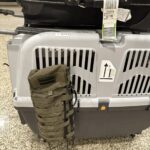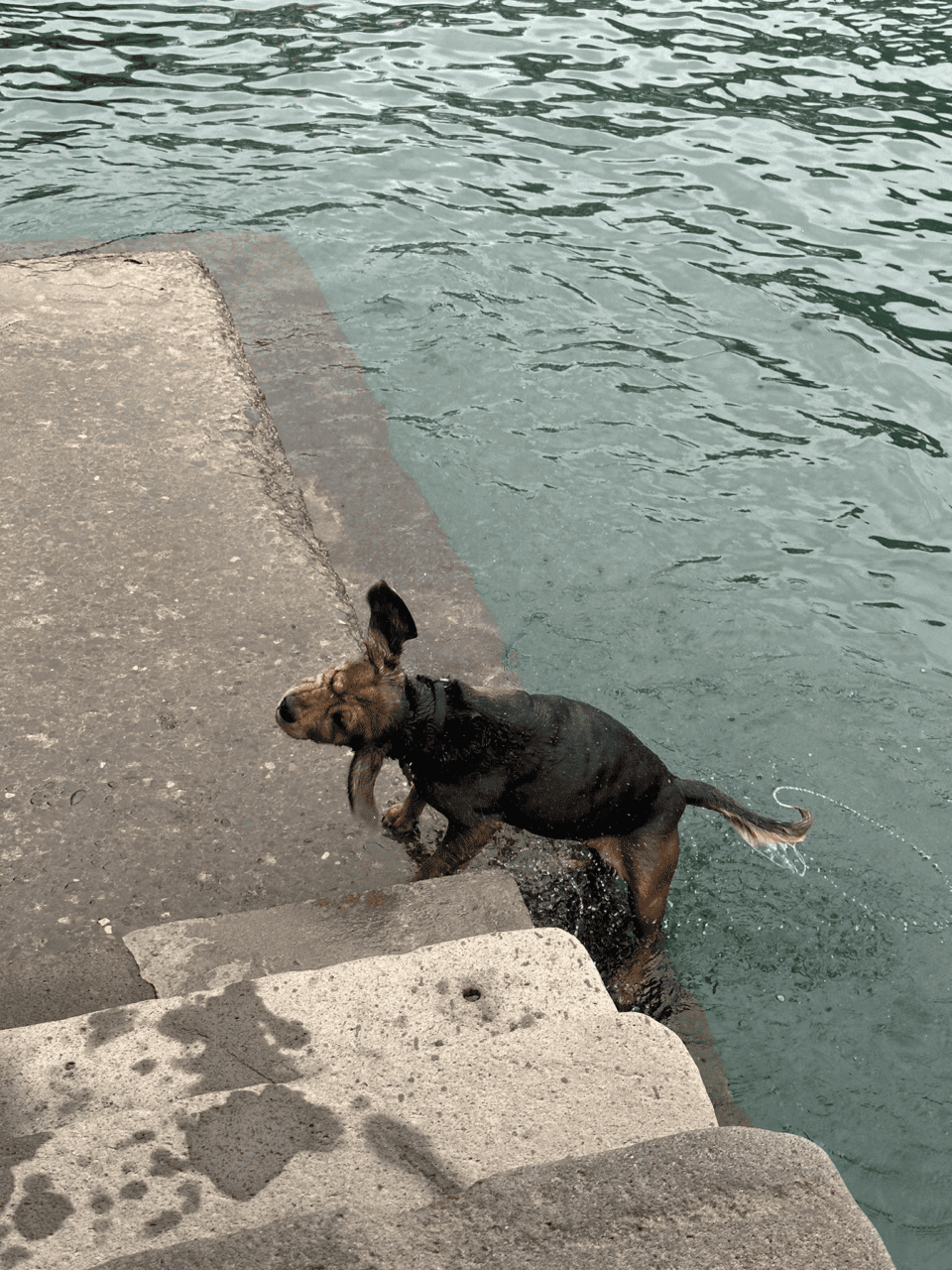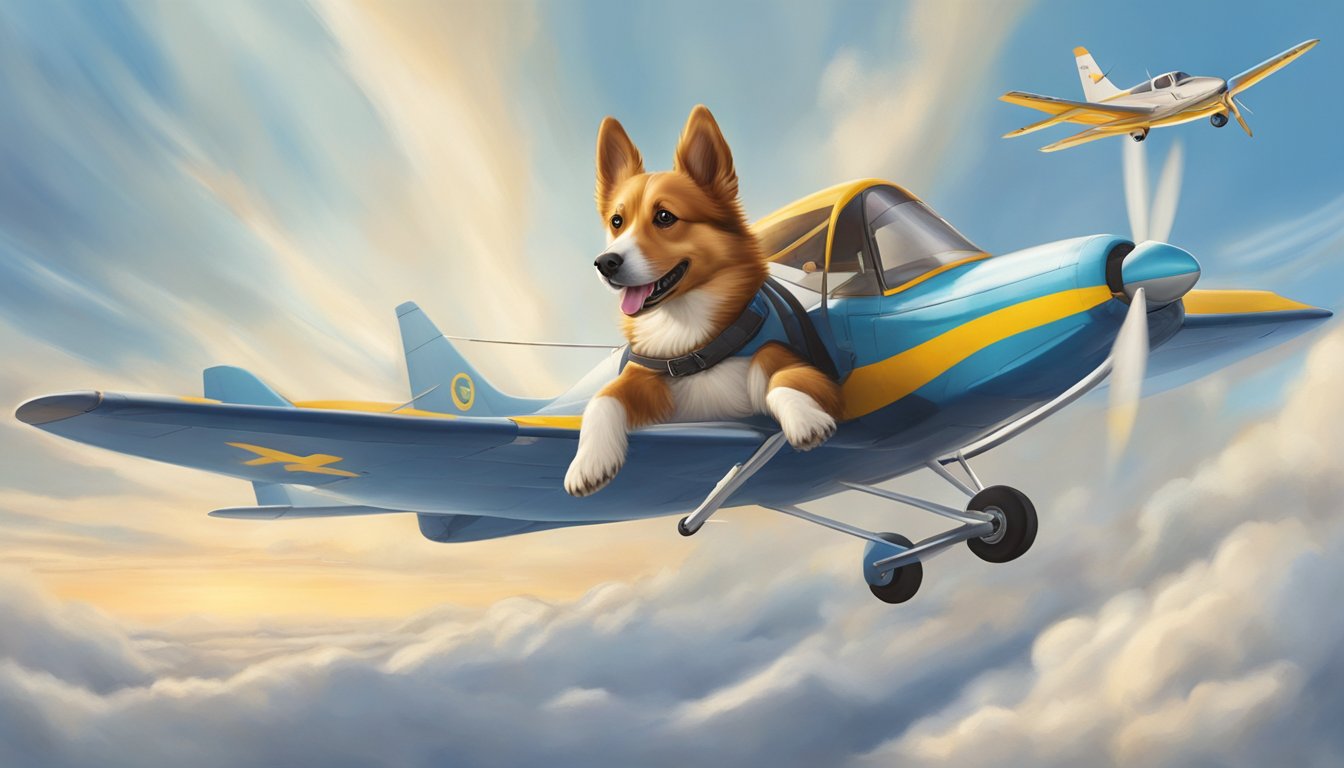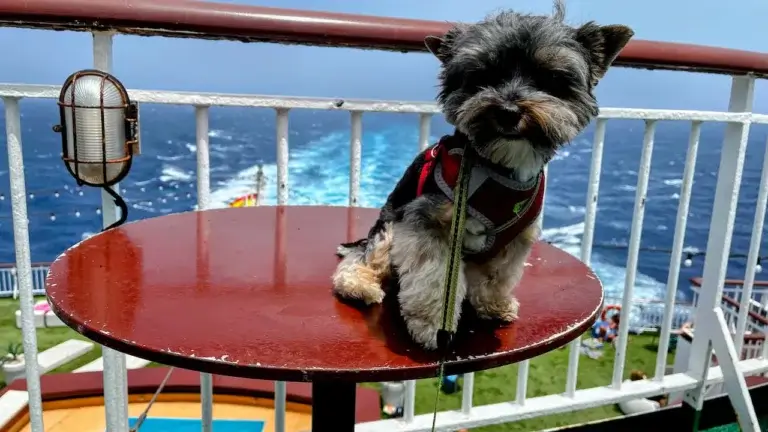Flying With a Dog in Europe: Experience-Based Guide and Tips
Traveling with your furry friend across Europe can be a memorable experience, but it can also be super stressful for both the owner and the pet.
Martins flew with his dog Poga (“Button” in English) from Latvia to Madeira. His experience should be useful to other dog owners who plan to fly with their pet across Europe.

The process can be divided into two main parts – preparation and departure – with airline regulations playing a significant role in shaping your travel plans. Once airborne, it should be straightforward.
As a dog owner, you should be prepared to put your desires on the back burner. The two main things that count are the airline regulations and your dog’s well-being and safety.
This article will guide you through the essential steps you need to take, from choosing the right airline to making sure your dog has the necessary transport equipment and documentation.
Key Takeaways
- Prepare well and understand airline regulations for a smooth pet travel experience
- Ensure your dog has proper transport equipment and documentation
- Double check everything and don’t rely only on information online, but call the representatives of the chose airline
This article is based on a series of tweets by Martins. See them by clicking on the link.
FINDING THE RIGHT AIRLINE
When you need to transport your pet by air, it’s crucial to find the right airline that accommodates animals and flies to your destination. If you’re traveling within the EU, please note that the rules are relatively similar across airlines, however, there can be key nuances you should be aware off.
To find the pet policy of the airline you consider flying with, simply Google “[airline name] pet policy”. Just as important – search for the pet policy of airports you’ll trnasit to ensure they handle animal cargo and if they have particular requirements.
Different airlines may have varied requirements, and some can be quite technical, e.g., specific cage dimensions or additional metal screws for securing the kennel (cage). Be prepared for airport staff to potentially check your pet’s cargo and require you to make last minute adjustments. They can also require that your pet willingly gets in and out of the cage.

Keep in mind the following when considering airline pet policies:
- Some airlines may allow dogs on international flights, while others allow pets only on connecting domestic flights.
- Animals weighing up to 8 kg can generally travel with passengers, while pets up to 32 kg are typically transported in the cargo hold.
- The weight limit includes the cage and attached accessories.
- Pets above 32 kg might be subject to different transportation methods and increased costs.
Remember to frequently review and re-read the pet policy you’re following, as some details might be missed initially. Choose an airline with a pet policy that suits your pet’s needs and double-check all requirements to ensure a smooth and hassle-free experience for both you and your beloved pet.

DOG TRANSPORT EQUIPMENT
When selecting a transport cage / kennel for your dog, it’s essential to find one that meets the International Air Transport Association (IATA) guidelines. When you plan to buy a kennel, check that it’s IATA-complianet, e.g., it’s written “IATA animal cage,” in the documentation. These cages are available online, but physical pet shops might not have a large selection in stock.

Make sure the cage is made of durable plastic and has a lockable door. Metal wire cages are not suitable for air travel. Ventilation is crucial, so choose a cage with openings on all sides. Additionally, the cage’s size should allow your dog to freely stand up at full height and provide enough space for the dog to lie down comfortably.
A mandatory requirement in dog transport cages is they have a drinking water container that can be refilled from the outside (so that airport / airline staff can do it without endangering themselves). Although you might not find a specific product for this purpose, you can improvize and use such solutions as birdcage containers etc.
For added safety and security, if the cage is assembled from two parts fasten both of them with zipties or other tensioners. Attach a plastic bag with extra zip ties on the outside of the cage, so airport staff can make adjustments if needed.
Carry at least one liter of water in a separate bag with you so that you can water your dog while he’s still with you.
On the day of travel, avoid feeding your dog to prevent any potential physiological issues. Instead, place a sleeping blanket and some familiar toys inside the cage to provide comfort and familiarity.
Introduce the transport cage to your dog about a week before your trip, allowing them to use it as their new sleeping place. This will help your pet get used to the cage, making the actual journey less stressful and more comfortable.
DOG PASSPORT AND VETERINARY “PAPERS”
To ensure your dog’s smooth travel, it’s essential to have an up-to-date dog passport and any other veterinary papers required by the airline’s or airport’s pet policy.
As a basic step, make sure all mandatory vaccinations are completed at least 21 days before your trip. Don’t forget to visit your vet for flea prevention treatment and a health check two days before your flight. The vet’s note that the pet is fit to travel is usually valid for five days only.
Stay informed and consult your veterinarian, as well as the airline about any additional requirements.
Based on experiences and vet’s recommendations, it’s generally best to avoid sedatives for your dog during travel, as they tend to cope well without them.
FLIGHT CHECK-IN
When planning to travel with your pet, it’s essential to be well-prepared. Here’s what you need to know about the flight check-in process when you’re bringing your furry friend on board.
Find Your Flight
- Search for your desired flight date and number. You can do this by “simulating” a ticket purchase and noting the flight details.
- Make note of alternative flight options, having at least three or four to choose from.
Consider Third-Party Operators
- Check if your chosen flight is operated by a third party.
- If it is, search for their “pet policy” as it may differ from the main airline’s policy.
Have Essential Information Handy
- Document the total weight and dimensions of your pet in their cage.
- Note your pet’s age or year of birth.
- Write down cage dimensions (height, length, and width).
Contact Airlines
- Before buying a ticket, call the specific airline to discuss pet accommodations. This can’t be stressed enough – call the airline, do not just rely on online information.
- Confirm if there’s room on the plane for your pet in the cabin or cargo compartment, mentioning the flight date and number.
- Keep records of all conversations and agreements with airline representatives. Double-check this information by calling again and talking to a different consultant.
Purchase Your Ticket
- After feeling confident about the pet’s chances of travelling with the selected flight, buy your ticket.
- Some airlines allow adding pet cargo and paying for it during ticket purchase, while others require separate arrangements.
Post-Purchase Arrangements
- If not already prepaid, contact the airline again, providing your flight reservation information.
- Arrange for any additional pet cargo fees that must be paid for at the airport on the day of departure.
Airport Operations
- Arrive at the airport at least 2 hours before your flight.
- If you have a connecting flight, ensure they are scheduled at least 3 hours apart so that there’s enough time to transfer our pet from one plane to the next.
- Be prepared for extra time registering your pet at the airport – different airports have different procedures, and some may require X-ray scanning of the cage.
Once everything is complete, congratulations – your pet is ready for takeoff! Don’t forget to benefit from the “special service” perks offered by airports when traveling with a pet, such as priority check-in for your other luggage.

IN CONCLUSION
Transporting your beloved pet by plane can indeed be a challenging and time-consuming task. Despite the complexities and high costs, it’s important to remember to treat your animal as more than just a suitcase.
Keep in mind, expenses can sometimes be higher than your own flight ticket! So, take the time to plan and prepare, ensuring a safe and comfortable journey for your furry friend.
If you have a smilar experience that could improve this article, please leave a comment below!
Frequently Asked Questions
Which European airlines allow dogs in the cabin?
Many European airlines allow dogs in the cabin, but policies can vary. Here’s a list of some airlines that generally accept dogs:
- Air France: Small pets, up to 8 kg, are allowed in the cabin on most flights.
- Lufthansa: Pets up to 8 kg are permitted in the cabin, but certain routes may have restrictions.
- KLM: Dogs weighing up to 8 kg can travel in the cabin with their owner on most flights.
- Swiss Air: Pets up to 8 kg can fly in the cabin. There are certain restrictions for larger breeds.
- Air Baltic: Pets up to 8 kg can fly in the cabin. There are certain restrictions for larger breeds.
Keep in mind that you should always check with the airline in advance to verify their specific pet policies.
How can I obtain an EU pet passport? What other EU requirements are there?
Visit a veterinarian authorized to issue pet passports. If your vet does not issue an EU pet passport, get a document that is recognized in the European Union or another European country that is not part of the EU.
What has to be in the pet passport? It should mention the following:
- The dog has been micro-chipped (in line with the technical requirements of Annex II of the EU Regulation on the movement of pets) or has a clearly readable tattoo if applied before 3 July 2011.
- The dog been vaccinated against rabies.
- The dog had treatment against the tapeworm Echinococcus multilocularis, where your destination area is free from this tapeworm (Finland, Ireland, Malta, Norway and Northern Ireland).
The EU rules described above on travelling with pet animals apply to private journeys with pet animals which do not involve a change of ownership or sale.
The relevant European Union rules.
How challenging is it to fly with a dog internationally in Europe?
Flying with a dog internationally in Europe can be a smooth experience if you plan ahead and follow the necessary steps:
- Confirm airline pet policies and book your dog’s flight accordingly.
- Obtain an EU pet passport and make sure your dog meets the necessary vaccination requirements.
- Prepare a comfortable carrier for your dog that meets the airline’s size and weight restrictions.
- Check for any additional pet import requirements for your destination country.
Which airlines should I avoid when flying with a dog?
Generally, the budget airlines like Ryanair and WizzAir allow only service dogs onboard. You will not be able to fly with your pet.
If you plan to fly with your family, they can choose a budget airline, but you will have to travel with a regular airline that transports dogs and other pets.
About the author

Martins is organizing hikes around Latvia and elsewhere in Europe for the past 10 years. He’s the spark behind Streelnieks.lv, a top Latvian online portal for people interested in active adventures. He’s most recent project are guided hikes in Madeira, as he has moved to the island with his family and dog Poga.


